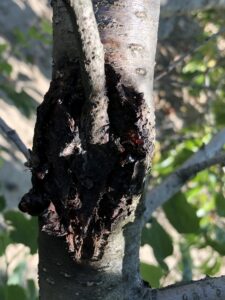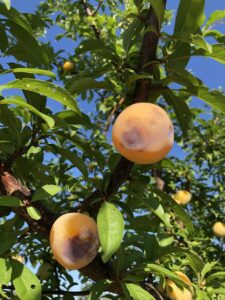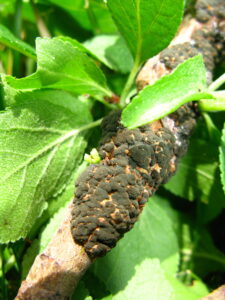Another warning for severe brown rot of stone fruits (apricot, cherry, nectarine, peach, plum) (Fig. 1). Warm, wet, humid weather at harvest is particularly favorable for this fungal disease. Also, as fruit softens during the ripening process, it becomes much more susceptible to brown rot. Carefully picking and handling fruit to avoid injuries prevents infection courts that brown rot is more than happy to exploit. If infection is severe, picking fruit a few days early and ripening off the tree may be required. Finally, when all is said and done, remove any remaining fruit from the tree after the final picking to prevent the possibility of overwintered mummies within the tree infecting susceptible blossoms next spring. This also gives you one less thing to do during your spring pruning and provides you with more latitude to selectively prune (in case of severe winter, hail, or animal damage) without increased risk of blossom infection. Pretty smart, eh?
More on Stone Fruit: Now is a good time to scout for Cytospora canker (Fig. 2). Key symptoms include dark, sunken areas with gum oozing through the bark on branches and limbs. Pruning thin, willowy water sprouts in the center of the tree right now prevents canker establishment within the main stem of the tree. This is key, as nothing can be done when the cankers get into the trunk. Do not use commercial wound paints on pruning cuts—I know, it makes you feel better, but it really messes up the tree—Just Don’t!

Figure 2. Cytospora canker often occurs around branch stubs of all stone fruit. Photo by Janna Beckerman.
When pruning side branches from larger limbs, the cut should be made just beyond the branch bark ridge, that ridge of thickened bark where the smaller branch joins the larger limb—But, as you cut carefully, do not cut flush to the main stem, and do not leave stubs! The branch bark ridge should not be removed because it is in this region where the most rapid wound healing occurs. Prune to open the center of trees to light penetration because shaded branches are weakened and more susceptible to winter injury and Cytospora infection. I know, that is a lot of “Do Not’s” but improper pruning can cause a lot problems in the future. Remove all dead and weakened wood and burn it immediately. Limb damage that occurs during the growing season should be repaired immediately; never wait for the dormant season.
Finally, while scouting plums, look for symptoms of black knot disease at the time of pruning (Fig. 3). These are rough, black tumors or overgrowths that develop on shoots and limbs and should be pruned out completely and destroyed. Keep in mind that 1st and 2nd year galls are easily overlooked so care should be taken while scouting to remove the obvious and not so obvious galls.

